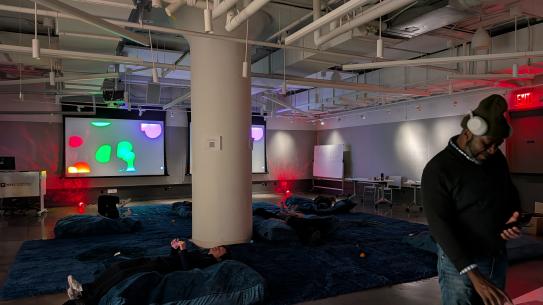Poly research ensures health of bridges and tunnels
 Adapting the old adage “An ounce of prevention is worth a pound of cure,” Dr. Masoud Ghandehari is leading the interdisciplinary research at Polytechnic to develop tools that will monitor the “health” of aging bridges, pipelines, highways and other structures.
Adapting the old adage “An ounce of prevention is worth a pound of cure,” Dr. Masoud Ghandehari is leading the interdisciplinary research at Polytechnic to develop tools that will monitor the “health” of aging bridges, pipelines, highways and other structures.
Ghandehari, assistant professor in the Department of Civil Engineering, is quick to point out that the early discovery of signs of aging in civil infrastructures will improve safety and save local governments millions of dollars spent annually in maintenance of bridges and tunnels.“A corollary to this approach is found in the early detection of a medical condition,” he notes.“If a medical malady is diagnosed early, it is often easier to treat and less expensive to cure.”
Working in Polytechnic’s Optical Diagnostics Laboratory, Ghandehari describes his research as “materials health management,” where we bring together teaching of analytical chemistry and materials engineering. He learned early in his career as a practicing engineer in New York City, working on the rehabilitation of aging bridges and tunnels that, in most cases, the sensing and diagnostic tools used for civil infrastructure identify physical damage, but are unable to identify the underlying chemical processes that contribute to infrastructure deterioration. Now his research in developing sensors to directly monitor such chemical processes has attracted the attention of the Port Authority of New York and New Jersey and the natural gas industry.
“We are working with the Port Authority on a number of major initiatives for field implementation of sensing devices in local bridges,” Ghandehari says. In addition, through funding from the natural gas industry, Ghandehari and his students are currently developing sensing systems for detection of subsurface gas leaks.“Long-term sensor durability is an essential requirement for civil infrastructure monitoring,” he explains.“We can make these optical fiber probes to be very robust for long-term applications in the harsh subsurface environments for decades.” Ghandehari points out that this research has also created opportunities for Poly students to obtain valuable industry internships. The student interns not only contribute to advancing research, but they also learn how to function in a professional setting and learn about product development and intellectual property.
Through a grant from the National Science Foundation, two of Ghandehari’s students, Mark Pytel ’07CE and Honors College scholar Narissa Puran ’08BmS, will travel to northern Germany to study at the University of Braunschweig. In this collaboration, the students will use the optical diagnostic methodologies developed at Polytechnic, while researchers from Braunschweig will offer their experience as a world leader in materials engineering.
According to Puran, the development of such optical sensing technologies could serve a variety of functions from medicine to material science. “I find the implications of Professor Ghandehari’s work very profound,” she says, “and that is why I plan to continue to be a research student in the Optical Diagnostics Lab during my undergraduate career at Poly.”
Ghandehari attributes the success of his research to the culture of collaboration at Polytechnic. “I have found a high level of expertise in areas that complement and support my research objectives,” he says.“I have also found openness on the part of University experts to span boundaries and work in a cross-disciplinary fashion.”
Dr. Farhad Ansari, head of the Department of Civil and Materials Engineering at the University of Illinois at Chicago, explains that Ghandehari’s research has stretched the state-of-the-art in the application of civil structural health monitoring to the point where it is possible to develop sensors for degradation monitoring of bridges. He adds,“This is an important contribution to the civil infrastructure system of our nation.”



